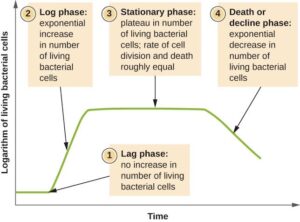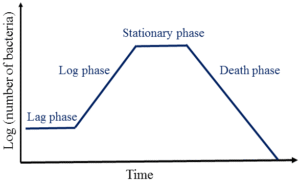Back to: MICROBIOLOGY 100 LEVEL
Welcome to class!
Hello, my eager learner! I’m so glad you’re back and ready to keep building your knowledge. Today, we’re going to talk about the growth phases of bacteria. Just like you have different moods or stages during the day—waking up slowly, being full of energy, resting, or getting tired—bacteria also grow in stages. These stages are called lag, log, stationary, and decline phases. Let’s look at each one so you can understand how bacteria grow and multiply!
Growth Phases: Lag, Log, Stationary, Decline
Lag Phase
This is the beginning stage. When bacteria are first introduced into a new environment (like fresh food or a clean lab dish), they don’t start multiplying immediately. Instead, they are busy getting ready—adjusting to their new surroundings and producing the tools they need to grow.

Think of this as when you just arrive at school, settling down, organising your books, and preparing for the day before starting lessons.
Log Phase (Exponential Phase)
Next comes the log phase, also called the exponential phase. This is when bacteria start dividing very quickly. They reproduce at their fastest rate, doubling in number over and over.
Imagine a classroom where everyone suddenly starts working hard and learning quickly—this is bacteria at their busiest and healthiest.
Stationary Phase
After a while, the growth slows down because the environment starts running out of food or space, and waste products build up. In this stationary phase, the number of new bacteria being born equals the number dying.
It’s like when a room gets too crowded, and people stop moving around much. The bacterial population stays stable but doesn’t grow anymore.
Decline Phase (Death Phase)
Finally, in the decline phase, conditions become harsh. Food runs out completely, waste becomes toxic, and more bacteria start dying than being born. The population decreases rapidly.

This is like the end of a long, tiring day when everyone is ready to go home and rest.
Summary
- In the lag phase, bacteria get ready to grow but don’t multiply yet.
- In the log phase, bacteria divide quickly and numbers increase fast.
- During the stationary phase, growth stops because resources run low.
- In the decline phase, bacteria start dying faster than they multiply.
Evaluation
- What happens to bacteria during the lag phase?
- Why does the log phase have rapid bacterial growth?
- What causes the stationary phase to happen?
- What is happening to the bacteria population during the decline phase?
Understanding these growth phases helps us know how to control bacteria—important in medicine, food safety, and many other areas. Keep up the great work, and remember Afrilearn is proud to be with you on this learning journey. See you next time, star student!
